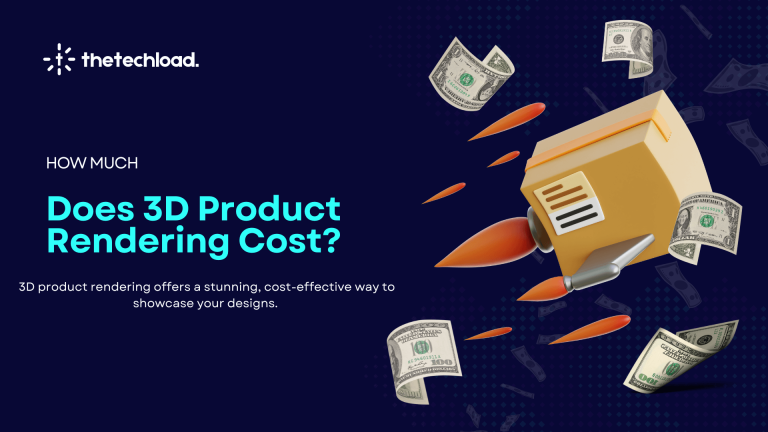Online shopping lacks the physical experience, making it hard for customers to judge products. 3D product rendering solves this by creating realistic digital models that accurately show textures, dimensions, and details. This boosts trust, improves engagement, and helps buyers make confident decisions.
E-commerce competition is tough, and product photos alone aren’t enough. 3D product rendering offers better visualization, enhances user experience, and reduces return rates. Businesses using it stand out and drive more sales.
Want to see how 3D rendering for e-commerce products can boost sales and enhance customer experience? Please keep reading to discover its impact.
Understanding 3D Product Rendering for E-commerce
3D product rendering is creating detailed digital representations of a product using specialized software. These images simulate real-world textures, lighting, and shadows, providing customers with an immersive shopping experience.
Unlike static images, 3D renders allow users to rotate, zoom in, and explore products from multiple angles, replicating an in-store experience online.
The 3D Rendering Process: How It Works
The process of creating a 3D product render involves several key steps:
- Modeling: A digital 3D model is created based on the product’s dimensions and design specifications.
- Texturing: Realistic surface properties, such as colors and materials, are applied to the model.
- Lighting: Appropriate lighting settings enhance the realism of the render.
- Camera Setup: Virtual cameras capture the product from multiple angles.
- Rendering: High-quality images are generated using advanced rendering software.
- Post-Production: Final adjustments, such as color correction and background additions, are made to optimize the image.
How to Use 3D Product Renders in E-Commerce
1. Prototyping
Companies use 3D rendering to visualize product concepts before manufacturing. This helps designers make necessary adjustments early, reducing production errors and costs.
2. E-Commerce Product Visualization
Online stores use 3D renders to replace traditional photoshoots, offering high-quality, customizable images that improve user experience and boost conversions.
3. Advertising Campaigns
Brands leverage 3D rendering to create visually compelling social media, websites, and digital marketing ads. These renders can highlight product features more engagingly than standard images.
Why 3D Product Rendering is a Game Changer for E-Commerce
Cost-Effective Alternative to Traditional Photography
Hiring professional photographers, setting up studios, and conducting product photoshoots can be expensive and time-consuming. 3D product rendering provides a more affordable solution, allowing businesses to create realistic product visuals without the costs of traditional photography.
With 3D product modeling for online stores, brands can generate multiple product variations, update designs, and create high-quality images without additional expenses. This cost-effective approach is helping businesses keep up with digital transformation in e-commerce.
Faster and Easier Product Visualization
Traditional product photography requires time for setup, shooting, and editing. With 3D product rendering, businesses can quickly create detailed visuals, making showcasing new designs or product updates easier.
This efficiency is essential in today’s fast-paced online shopping trends, where customers expect high-quality images instantly.
The importance of product visualization cannot be overstated; explicit, detailed visuals help customers make confident buying decisions.
Seamless Customization for Better Customer Experience
Customers love personalization, and 3D product rendering enhances user experience in e-commerce by offering customizable visuals. Shoppers can modify colors, materials, and features in real time, increasing engagement and boosting conversion rates.
For instance, a furniture retailer using e-commerce branding with 3D technology can let customers see a sofa in different fabrics before purchasing. This level of customization improves the virtual product demonstration experience, making online shopping feel more interactive.
Reduces Product Returns and Boosts Buyer Confidence
One major challenge in e-commerce is high return rates due to inaccurate product images. Product rendering for better sales ensures customers get a clear, accurate representation of items, reducing dissatisfaction.
By providing realistic product visuals, brands can build trust and transparency, leading to fewer returns. Shoppers feel more confident seeing products from multiple angles and in different settings before purchasing.
Perfect for Marketing and Advertising Campaigns
Strong visual content marketing is crucial for e-commerce success. 3D product rendering helps brands create high-quality visuals for websites, social media, and advertising campaigns.
Unlike traditional photos, 3D renders can be repurposed for different platforms, ensuring consistency and engagement. This flexibility supports e-commerce branding with 3D technology, helping brands stand out in a competitive market.
Ideal for Augmented Reality (AR) Shopping Experiences
As AR shopping gains popularity, 3D product modeling for online stores enables customers to visualize products in their own space before buying. This enhances the importance of product visualization, making online shopping more immersive and interactive.
For example, eyewear brands use virtual product demonstrations to let customers try on glasses, while furniture retailers allow users to place virtual sofas in their homes.
This innovative approach improves enhanced user experience in e-commerce, leading to better customer satisfaction.
The Future of E-Commerce: Scalable and Sustainable
3D product rendering is shaping the future of digital transformation in e-commerce. It offers businesses a scalable and sustainable way to showcase products. It eliminates the need for physical samples and large-scale photoshoots, reducing waste and costs.
As technology advances, businesses that integrate product rendering for better sales will stay ahead of evolving online shopping trends.
AI-driven customization and real-time 3D visualization will soon become standard, making 3D rendering an essential tool for modern e-commerce.
How to Choose the Right 3D Rendering Service for Amazon Products
When selecting a 3D product rendering service, consider the following factors:
- Experience & Expertise: Choose a provider with experience in e-commerce rendering, particularly for Amazon listings.
- Portfolio & Quality: Review previous work to ensure the service aligns with your brand aesthetics and meets Amazon’s image requirements.
- Customization & Scalability: Ensure the service offers customization options and can handle bulk product rendering.
- Pricing & Turnaround Time: Compare pricing and delivery timelines to find a provider that fits your budget and schedule.
How does The Techload help you?
The Techload specializes in creating high-quality, photorealistic 3D product renders tailored for e-commerce success. Our expert team ensures your products are showcased with precision and creativity, enhancing customer engagement and boosting conversion rates.
From detailed modeling to seamless customization, we provide scalable, cost-effective solutions to elevate your Amazon listings and digital marketing efforts. Let The Techload help you stay ahead in the competitive world of online selling.
Conclusion
3D product rendering has transformed the e-commerce landscape by offering better product visualization, enhancing the customer experience, and improving conversion rates. It allows businesses to stay competitive, reduce costs, and provide an interactive shopping journey that increases buyer confidence.
As technology continues to evolve, the integration of 3D rendering will become even more essential for online retailers looking to thrive in a rapidly changing market.
3D Product Rendering for E-Commerce: FAQs
Amazon sellers should consider using 3D rendering services to increase product visualization, customer interaction, and ultimately boost sales.
As technology continues to advance, I can expect to see more realistic and immersive 3D renders, as well as integration with emerging technologies like virtual and augmented reality.
Creating 3D renders can be more cost-effective than multiple professional photoshoots. Hourly rates for rendering services start between $20 and $150.




